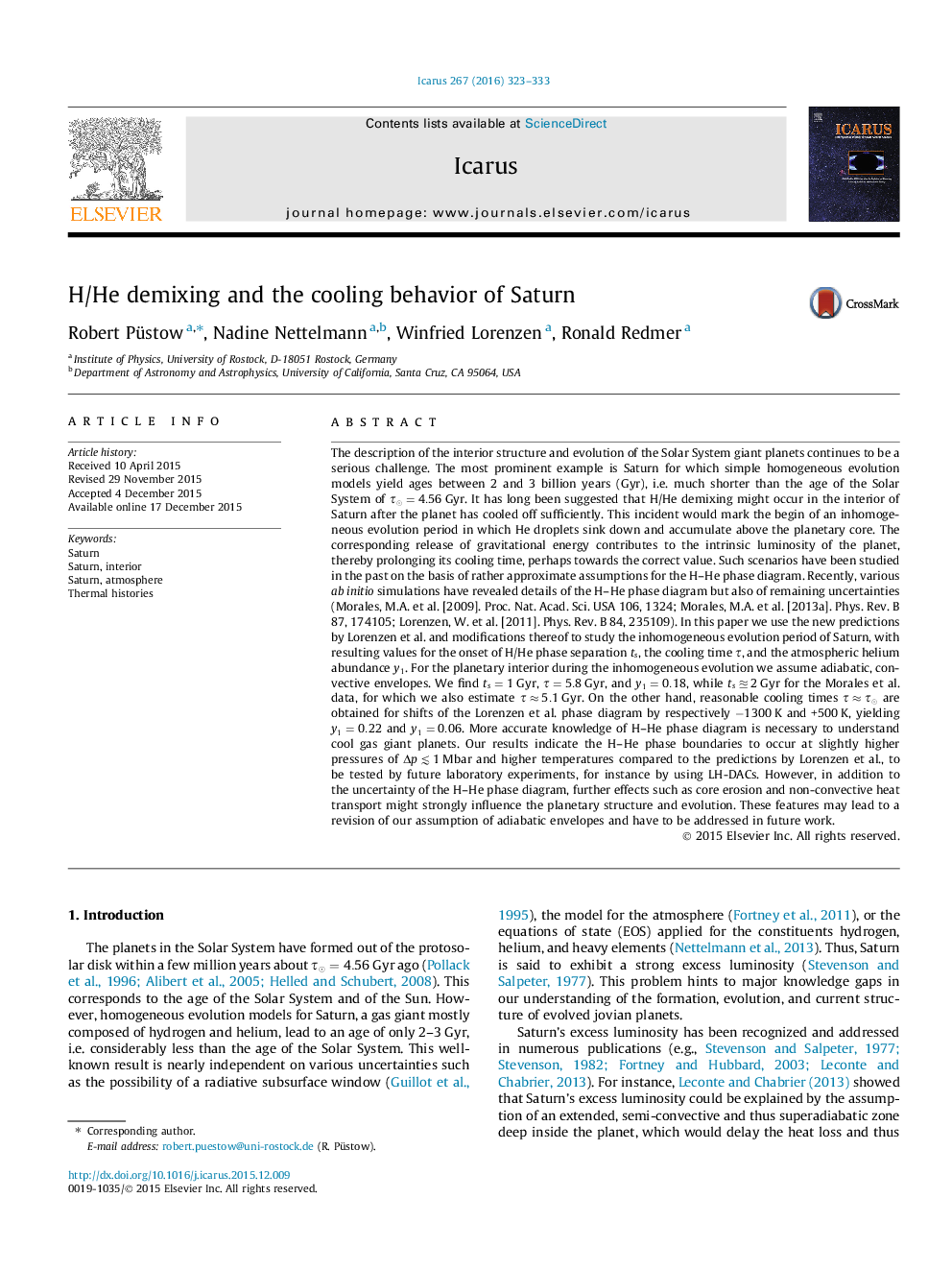| کد مقاله | کد نشریه | سال انتشار | مقاله انگلیسی | نسخه تمام متن |
|---|---|---|---|---|
| 8135737 | 1523523 | 2016 | 11 صفحه PDF | دانلود رایگان |
عنوان انگلیسی مقاله ISI
H/He demixing and the cooling behavior of Saturn
دانلود مقاله + سفارش ترجمه
دانلود مقاله ISI انگلیسی
رایگان برای ایرانیان
کلمات کلیدی
موضوعات مرتبط
مهندسی و علوم پایه
علوم زمین و سیارات
علوم فضا و نجوم
پیش نمایش صفحه اول مقاله

چکیده انگلیسی
The description of the interior structure and evolution of the Solar System giant planets continues to be a serious challenge. The most prominent example is Saturn for which simple homogeneous evolution models yield ages between 2 and 3 billion years (Gyr), i.e. much shorter than the age of the Solar System of Ïâ=4.56 Gyr. It has long been suggested that H/He demixing might occur in the interior of Saturn after the planet has cooled off sufficiently. This incident would mark the begin of an inhomogeneous evolution period in which He droplets sink down and accumulate above the planetary core. The corresponding release of gravitational energy contributes to the intrinsic luminosity of the planet, thereby prolonging its cooling time, perhaps towards the correct value. Such scenarios have been studied in the past on the basis of rather approximate assumptions for the H-He phase diagram. Recently, various ab initio simulations have revealed details of the H-He phase diagram but also of remaining uncertainties (Morales, M.A. et al. [2009]. Proc. Nat. Acad. Sci. USA 106, 1324; Morales, M.A. et al. [2013a]. Phys. Rev. B 87, 174105; Lorenzen, W. et al. [2011]. Phys. Rev. B 84, 235109). In this paper we use the new predictions by Lorenzen et al. and modifications thereof to study the inhomogeneous evolution period of Saturn, with resulting values for the onset of H/He phase separation ts, the cooling time Ï, and the atmospheric helium abundance y1. For the planetary interior during the inhomogeneous evolution we assume adiabatic, convective envelopes. We find ts=1 Gyr, Ï=5.8 Gyr, and y1=0.18, while tsâ2 Gyr for the Morales et al. data, for which we also estimate Ïâ5.1 Gyr. On the other hand, reasonable cooling times ÏâÏâ are obtained for shifts of the Lorenzen et al. phase diagram by respectively â1300 K and +500 K, yielding y1=0.22 and y1=0.06. More accurate knowledge of H-He phase diagram is necessary to understand cool gas giant planets. Our results indicate the H-He phase boundaries to occur at slightly higher pressures of Îpâ²1 Mbar and higher temperatures compared to the predictions by Lorenzen et al., to be tested by future laboratory experiments, for instance by using LH-DACs. However, in addition to the uncertainty of the H-He phase diagram, further effects such as core erosion and non-convective heat transport might strongly influence the planetary structure and evolution. These features may lead to a revision of our assumption of adiabatic envelopes and have to be addressed in future work.
ناشر
Database: Elsevier - ScienceDirect (ساینس دایرکت)
Journal: Icarus - Volume 267, 15 March 2016, Pages 323-333
Journal: Icarus - Volume 267, 15 March 2016, Pages 323-333
نویسندگان
Robert Püstow, Nadine Nettelmann, Winfried Lorenzen, Ronald Redmer,